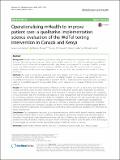Optimising Age Adjustment of Trichiasis Prevalence Estimates Using Data from 162 Standardised Surveys from Seven Regions of Ethiopia
View/
Publication Date
2018-12-28Type
Article, Journalviews
downloads
Metadata
Show full item recordCitation
Colin K. Macleod, Travis C. Porco, Michael Dejene, Oumer Shafi, Biruck Kebede, Nebiyu Negussu, Berhanu Bero, Sadik Taju, Yilikal Adamu, Kassahun Negash, Tesfaye Haileselassie, John Riang, Ahmed Badei, Ana Bakhtiari, Rebecca Willis, Robin L. Bailey & Anthony W. Solomon (2019) Optimising age adjustment of trichiasis prevalence estimates using data from 162 standardised surveys from seven regions of Ethiopia, Ophthalmic Epidemiology, 26:3, 161-168, DOI: 10.1080/09286586.2018.1555262
Abstract/
Purpose: The prevalence of trichiasis is higher in females and increases markedly with age. Surveys carried out in the daytime, particularly in developing countries, are prone to find older individuals and females at home at the time of the survey. Population-level trichiasis estimates should adjust sample proportions to reflect the demographic breakdown of the population, although the most accurate method of doing this is unclear. Methods: Having obtained data from 162 surveys carried out in Ethiopia as part of the Global Trachoma Mapping Project from 2012 to 2015, we used internal validation with both Brier and Logarithmic forecast scoring to test stratification models to identify those models with the highest predictive accuracy. Selection of partitions was undertaken by both simple random sampling (SRS) and cluster sampling (CS) over 8192 selections. Results: A total of 4529 (1.9%) cases of trichiasis were identified from 241,139 individuals aged ≥15 years from a total of 4210 kebeles and 122,090 households visited. Overall, the binning method using 5-year bands from age 15 to 69 years, with coarser binning in 20-year age-bands above this age, provided the best predictive accuracy, in both SRS and CS methodologies and for both the Brier and Logarithmic scoring rules. Conclusion: The greatest predictive accuracy for trichiasis estimates was found by adjusting for sex and in 5-year age-bands from the age of 15 to 69 years and in 20-year age-bands in those aged 70 years and greater. Trichiasis surveys attempting to make population-level inferences should use this method to optimise surgery backlog estimates.
Subject/
Trachoma; Trichiasis; Population-based prevalence survey; Global Trachoma Mapping Project
Further Details
© 2018 World Health Organization. Published with license by Taylor & Francis. This is an Open Access article distributed under the terms of the Creative Commons Attribution License (http://creativecommons.org/licenses/by/4.0/), which permits unrestricted use, distribution, and reproduction in any medium, provided the original work is properly cited.
Publisher
Taylor & FrancisISSN
ISSN: 0928-6586 (Print); 1744-5086 (Online)Collections
- General - GEN [367]

